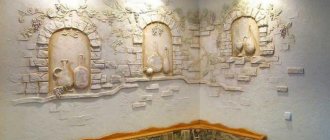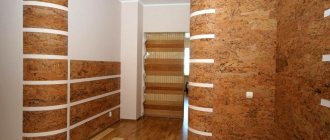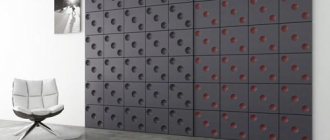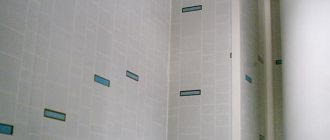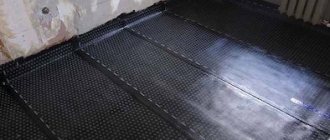Often in construction processes it is permissible to see the plaster of walls without the use of beacons. Plastering walls with your own hands without beacons can achieve efficient spending on materials, resources, as well as on your own resources.
The presence of smooth geometric walls is an optional factor, since for economic auxiliary structures, in their absence, the situation will not be critical. If the plastered surfaces do not require an accurate and even plane, then technologies are used to plaster the wall without a beacon.
Why plaster a surface without beacons?
During construction work, the finishing must be done in good faith. However, there are common situations in which such an approach is justified.
This is especially suitable for utility rooms (for example, a workshop, barn, poultry house and other outbuildings), which can be located behind your own house, and for such structures ideal walls are completely unnecessary. It is also quite suitable for them to appear smooth in appearance, with no noticeable effect on the surface, and for the original materials themselves to gain reliability during the construction period. If the masonry was carried out in a careful manner, and the verticality of the plane and the straightness of the row were regularly checked, then the leveling work without beacons will take place without additional complications.
There will be no significant difficulties when plastering, as a rule, without beacons, auxiliary structures in private buildings, internal walls in garages, as well as boiler shops, etc. Thanks to thin plaster layers, it is possible to hide external irregularities and prepare surfaces, for example, for painting or whitewashing, and the procedure for checking an accurate, even plane is recommended to be carried out using a rule.
There will be no significant difficulties when plastering as a rule without beacons.
How to prepare walls for plastering without beacons
Before plastering walls without beacons, they must be brought into proper condition. How the layer of plaster applied without beacons will hold up depends on this stage of work. The surface is cleaned of dirt and dust, washed with warm water or wiped with a damp cloth. Anything that might be in the way should be removed: wall defects, protruding nails, construction staples, protruding lumps of plaster, frozen drops of cement mortar.
It is impossible to plaster a smooth surface without using beacons. The biggest problem is oil paint, which builders of the last century loved to use. It is completely knocked down or removed with a solvent, and if this is not possible, frequent grooves are made with an ax. The solution also does not stick well to a wooden wall; it is covered with thin wooden slats located diagonally. A concrete wall will hold the plaster better if notches are made first. A brick wall does not require mechanical preparation before plastering without beacons.
The entire surface is treated with a primer. It is selected according to the type of surface, usually recommendations for use are given on the packaging. Application occurs from top to bottom. It is a mistake to carry out work on leveling walls without using beacons immediately after applying the soil mortar. In accordance with the instructions for use, you should wait 12 hours and then begin the procedure.
Where is this method used?
To level any surface, you can use a number of methods that allow you to apply plaster. This or that method is selected taking into account the specific conditions and convenience of the plasterers themselves.
Conventionally, plastering walls without the use of beacons can be divided into a number of subtypes, which will directly depend on the quality of the original surface:
- In the case of a flat wall, if there are minor depressions, the surface is leveled using a rule, and the composition itself is applied using a spatula;
- When the walls are smooth, the deviation may appear near the edge of the wall (in those places where they could sink). In such a situation, any compounds applied along the edge must be leveled with a rule that will rest against the flat surface of the remaining walls;
- If there are significant deviations, then it is necessary to create an oriented line or path - this may resemble mortar beacons;
- With the visual method, an oriented line is drawn on the adjacent plane.
In the case of a flat wall, if there are minor depressions, the surface is leveled using a rule, and the composition itself is applied using a spatula.
Stages of work without using beacons
The totality of the work described above can be divided into several stages. First of all, you should take care of the appropriate tools for future construction work. If all the necessary tools are available and ready for full operation, then preparatory work should be carried out, namely, mix the solution and begin the process of plastering walls without beacons. The final stage will be grouting the plaster.
First of all, you should take care of the appropriate tools for future construction work.
Tools for work
Before talking about the tools required for the work, the whole process will entirely depend on the composition of the wall (in particular, what the structure is made of, brick, wood, etc.). It would be a good idea to check the walls for curvature, and for this you will need to use a scale, level and other auxiliary tools.
It is important to select a list of necessary devices:
- Spatulas that allow you to easily apply plastering and filling compounds;
- Brushes with needles to clean walls from dirt;
- A hammer that allows you to knock down unusable coating;
- Rule.
It would be a good idea to check the walls for curvature, and for this you will need to use a scale, level and other auxiliary tools.
Preparatory work
How to plaster walls without beacons, step by step:
- Measure the coating being treated.
- It is necessary to clean the walls of old plaster. This work may require trowel hammers and brushes. If muffled sounds are heard, this may mean that the old materials have fallen behind. They need to be excluded.
- In the future, you will need to dismantle switches and sockets.
- Many small cracks must be repaired using plaster mixtures three days before leveling the surface begins.
- In cases where the surface of the walls consists of wood, it is necessary to provide finishing using slats and shingles. If the surface consists of brickwork, then no additional actions will be required. The plaster layer will be able to catch on the seam between the brickwork.
- Unevenness can be removed using nets. Subsequently, the entire surface is treated with a primer composition.
It is necessary to clean the walls of old plaster.
Preparation of the solution
Before approaching the stage of mixing the compositions, it is important to decide on the mixtures used for subsequent work.
Plaster without beacons technology and solutions
An even angle of the walls should be ensured with the help of compositions that are not expensive in terms of prices and conditions suitable for this, when using the appropriate plaster mixture. Inside non-damp structures, it is important to use a gypsum mixture, since it is characterized by environmental qualities, as well as ease of use during application and shaping, and also instant strength. Gypsum - allows you to recreate the evenness of the ceiling, since the coating level provides a small mass.
This set of mixtures is characterized by plasticity. It is used for decorative finishing. Gypsum has many advantages, but is susceptible to the effects of any liquids, which means it is not suitable for plastering a bathroom or inside damp rooms.
Gypsum - allows you to recreate the evenness of the ceiling, since the coating level provides a small mass.
It is necessary to note the popularity of cement, with the presence of sand fillers that allow proper leveling of the wall. The mixture, with the presence of a cement binder, is capable of excellent characteristics, including strength, water resistance, and frost resistance. The use of the presented compositions can be used to level facades, basements, and also bathrooms.
Most of the above compositions can be classified as mineral plaster. In general, the disadvantages of the solution are its immunity to vibrations, as well as shrinkage inside structures. In cases where walls are plastered with your own hands using a gypsum mixture without beacons in earthquake-prone areas, it is recommended to use polymer-based compositions.
The mixture, with the presence of a cement binder, is capable of excellent characteristics, including strength, water resistance, and frost resistance.
Preparatory stage
Today, many are interested in the question of how to plaster walls with their own hands without beacons? Plastering walls with your own hands without beacons is, as a rule, impossible without preparing the main work. With proper preparation of the base and high-quality plastering of wall coverings, a 100% result is guaranteed.
It is necessary to clean the surface of the walls, repair, prime and dry, and for this it is necessary to ensure step-by-step work:
- Remove the unsuitable layer or area containing the finishing.
- Join the masonry joint or apply notches to the concrete base.
- Open up the cracks.
- Remove dusty areas.
- Clean the bases from grease stains, wash off other surfaces, and also degrease the area where rot, mold and fungi predominate.
- Repair significant chips and cracks (and, if possible, provide reinforcement using a special mesh).
- Ensure that the solution is applied in two layers with intermediate drying (use a special product for soil work).
- Wait for the wall surface to dry for 24 hours.
With proper preparation of the base and high-quality plastering of wall coverings, a 100% result is guaranteed.
The list of key devices and compositions includes:
- Dry or ready-made plaster mixtures, and also compositions;
- Means for providing priming;
- Plain water, and also auxiliary containers.
You may also need:
- Special containers for kneading the solution;
- As a rule, with the presence of a level;
- Brushes, as well as rollers, to preserve layers for the primer composition;
- Mixer;
- Spatula (49 cm and 9 cm, respectively);
- Grater;
- Sandpaper;
- List of special devices to eliminate previous layers of plaster.
In some cases, work must be carried out at height (when working on the ceiling or the top of walls), where specialists use special stepladders with small scaffolds. During work with the presence of lime mixtures, special masks, suits and glasses are used.
During work with the presence of lime mixtures, special masks, suits and glasses are used.
How to plaster walls without beacons
Before starting work, you will need to wet the walls with cold water. This will allow the solution to securely adhere to the walls.
Technologically, it looks like this:
- A rough surface is created.
- A correction type layer is applied.
- Work is being carried out on the finishing layer.
- Grouting is ensured to the required level of smoothness.
If you have a laser level, the work is performed as follows:
- The wall is primed.
- Markings for the guides are marked, and an angle of 5 cm is marked on the adjacent wall.
- A laser level is installed so that the vertical beams of the device pass along the marks on the walls.
- As a rule, according to the beam, it is important to press the tool against the wall. If the rays follow the marks, then there are no serious irregularities in the walls.
- The composition is mixed and spread along the marks.
Grouting is ensured to the required level of smoothness.
Plastering walls with your own hands without beacons using gypsum mixture
To ensure the evenness of the walls without using beacons, it is important to use gypsum.
Before purchasing a gypsum mixture, you should carefully study the technological conditions, which say how long it takes for the solution to harden.
Among the main tools you will need:
- Mixer;
- Set of spatulas;
- Two rules;
- Water (cold);
- Plaster composition;
- Containers for preparing mixtures.
The process consists of several stages:
- Kneading the dissolved mixture. Mixing with large portions is not recommended.
- Preparatory stage. It is important to ensure the pre-treatment of the walls in order to then begin to work with them safely, namely, to eliminate dirt, dust residues, fats, etc.
- Apply the mixture to the wall. The work is carried out with a spatula. The mixture is applied to the plane of the walls where there is unevenness. Alignment is ensured by the rule - from bottom to top.
To ensure the evenness of the walls without using beacons, it is important to use gypsum.
Grouting plaster
During grouting or smoothing, many irregularities, stripes and roughness are eliminated. The mashing procedure must be approached only at the moment when the previous layers have set and become covered with strong crusts. As soon as the grouting procedure is completed, after 9 hours, it is recommended to apply an additional layer.
During grouting or smoothing, many irregularities, stripes and roughness are eliminated.
Wall plastering technology
Activities associated with applying plaster mixtures without beacons are always dusty, very dirty, and require special attention and skills. That is why a team of professionals is most often hired to carry them out. The cost of plastering directly depends on the amount of work and the shape of the surface.
If the budget for work is very limited, do not despair. It is quite possible to level walls without beacons with your own hands. The main thing is to adhere to the basic rules and recommendations of professionals, take your time and do everything carefully; you can also study several video tutorials in our article.
Preparatory work
The first thing to do is to carefully remove all old decorative elements and wall decoration. The walls must be cleaned to the very base and dried well.
If the wall is made of brickwork, then for better adhesion to the plaster, deepen the seams between the bricks by 1-2 cm.
It is necessary to make notches on a smooth concrete surface. To do this you will need a hammer and a file. The notches should be quite frequent and at least 2 mm deep.
For wooden surfaces it is necessary to install lathing. To do this, use special thin slats or plywood trims. The material is stuffed diagonally onto the wall.
The walls are cleaned of dust and dirt. Brick or wood wall surfaces must be moistened with water. For these purposes, it is very convenient to use a garden sprayer, or simply use a broom.
Concrete walls must be treated with a primer. If the wall is made of foam concrete or sand-lime brick, then it is necessary to use a primer of higher penetration. All further work on applying the plaster mixture must be carried out after the wall is completely dry.
Preparation of plaster mortar
If the plaster is not prepared from individual components, but ready-made dry mixtures are used, then the manufacturer’s instructions must be strictly followed. As an example, we can consider the preparation of the most popular plaster mixture Rotband. For a bag of dry mixture weighing 30 kg, you need to prepare 18 liters of warm water.
Pour water into any convenient container, then add seven trowels of dry mixture. Mix everything thoroughly, and then add the remaining plaster, and mix everything again using a construction mixer. Everything possible must be done to ensure that the finished plaster is lump-free. Let the prepared composition sit for 4-6 minutes, and then mix everything again.
Advice! The solution prepared by yourself must be used within half an hour. If your experience does not yet allow you to plaster walls without beacons so quickly, then it is better to knead the first batch of the mixture in smaller volumes.
After preparing the solution, we begin applying plaster to the wall without using beacons. The technological process involves applying several layers one after another.
Apply the first layer - “spray”
In order to apply the first layer, the plaster must have a special consistency slightly thicker than sour cream. The spray layer for brick or stonework is about 5 mm, for wood - 10 mm.
We take a portion of plaster onto a trowel and throw the mixture onto the wall surface in any order. Throwing is done only with a brush, but in no case with the whole hand. To prevent the solution from splashing in all directions, the swing does not need to be very large.
Also, when applying the first layer, a method called “spreading” is used. The container is brought to the wall, the finished plaster is scooped up with a spatula and spread evenly over the wall. Once the solution is applied to the surface, there is no need to carefully level it. It is only necessary to remove the protruding areas of the plaster.
Advice! After the work is completed and the selected area of the wall is plastered, it is necessary to wash all tools very thoroughly.
Apply a second layer of “primer” to the wall
The second stage of plastering without beacons is the application of a layer called “soil”. To do this, prepare a special dough-like plaster. You can begin work only after the first layer of plaster has dried well. We check readiness as follows: press the plastered surface with a finger and if it does not change its shape, then the layer is completely dry.
The plaster mixture is thrown onto the wall, trying to fill the empty areas as best as possible. Then the plaster is leveled using a rule starting from the floor and ending at the ceiling. Excess is immediately removed. If empty areas appear during leveling, they must be immediately filled with the remaining solution and leveled again using the rule.
The final smoothness is achieved using a special tool - a grater. It is driven along the surface in a vertical and horizontal direction.
Apply the third layer of “wash”
In order to apply the third final layer of plaster to the wall, it is necessary to prepare a solution whose consistency resembles sour cream. The third layer is designed to remove even the most minor blemishes that may remain after applying the previous two layers. The thickness of the plaster is no more than 2 mm. In order for the mixture to have the best adhesion to the surface, it must be properly diluted. To do this, all dry ingredients are sifted through a fine sieve and thoroughly mixed with water until the lumps completely disappear.
We moisten the already plastered wall with water. Using a trowel, apply a very thin layer of plaster. As a rule, carefully level the plaster using circular or wave-like movements. We grout the surface without waiting for the wall to dry completely.
Advice! At any stage of plastering walls with your own hands, it is important to control the quality of the work performed. For this purpose, it is best to use a rule.
Surface care
If plastered correctly, no maintenance will be required. However, it is necessary to note two important criteria - spraying and priming. When sprayed for the preparatory layer, reliable retention of the solution is ensured. The main action is to completely cover the entire surface with water. There is no need to pay special attention to alignment. To ensure high-quality spraying, thick mixtures are prepared, since they will be securely attached to the plane of the wall. It is allowed to use a spatula or grater.
During the priming period, the main goal is to fill most of the flaws on the planes of the walls with mixtures, and as a result, reach the required layers of plastering and ensure maximum leveling of the walls. You can proceed to this step at the moment when the primary layer is securely grasped.
During the priming period, the main goal is to fill most of the flaws on the wall planes with mixtures.
It is permissible to level the walls according to the rule without beacons independently, even in the absence of any experience in installation work. It is important to follow the technology and listen to advice from experienced craftsmen. Only thanks to this, it will be possible to ensure good results.

